Creativity and Innovation Essay: Body Shape, Ocean Cleanup, and Future
VerifiedAdded on 2021/04/17
|7
|1855
|30
Essay
AI Summary
This essay delves into the multifaceted concepts of creativity and innovation, examining how they manifest in various aspects of life. The first section explores the evolution of human body size and shape, attributing these changes to factors such as climate change, dietary shifts, and ecological opportunities. The essay highlights the impact of innovations like adaptive radiations and dietary inventions on human physical characteristics. The second part focuses on the application of creativity and innovation to address environmental challenges, specifically discussing The Ocean Cleanup organization and its efforts to remove plastic waste from oceans. The essay examines the organization's methods, including its V-shaped array and water wheel device, and the significance of its work in mitigating the effects of plastic pollution on marine ecosystems. The essay concludes with a discussion of future trends in human evolution and the potential challenges and innovations needed for survival.
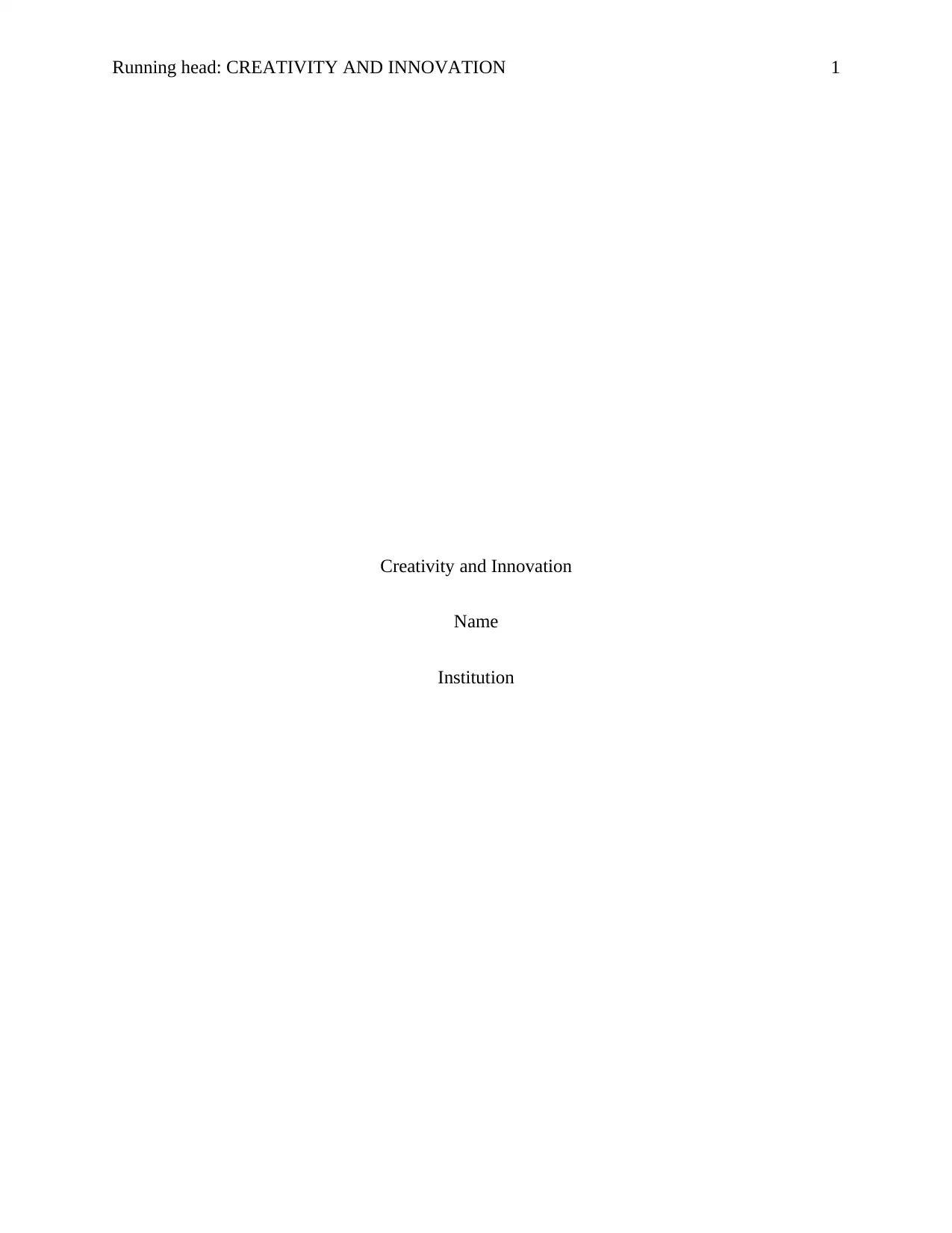
Running head: CREATIVITY AND INNOVATION 1
Creativity and Innovation
Name
Institution
Creativity and Innovation
Name
Institution
Paraphrase This Document
Need a fresh take? Get an instant paraphrase of this document with our AI Paraphraser
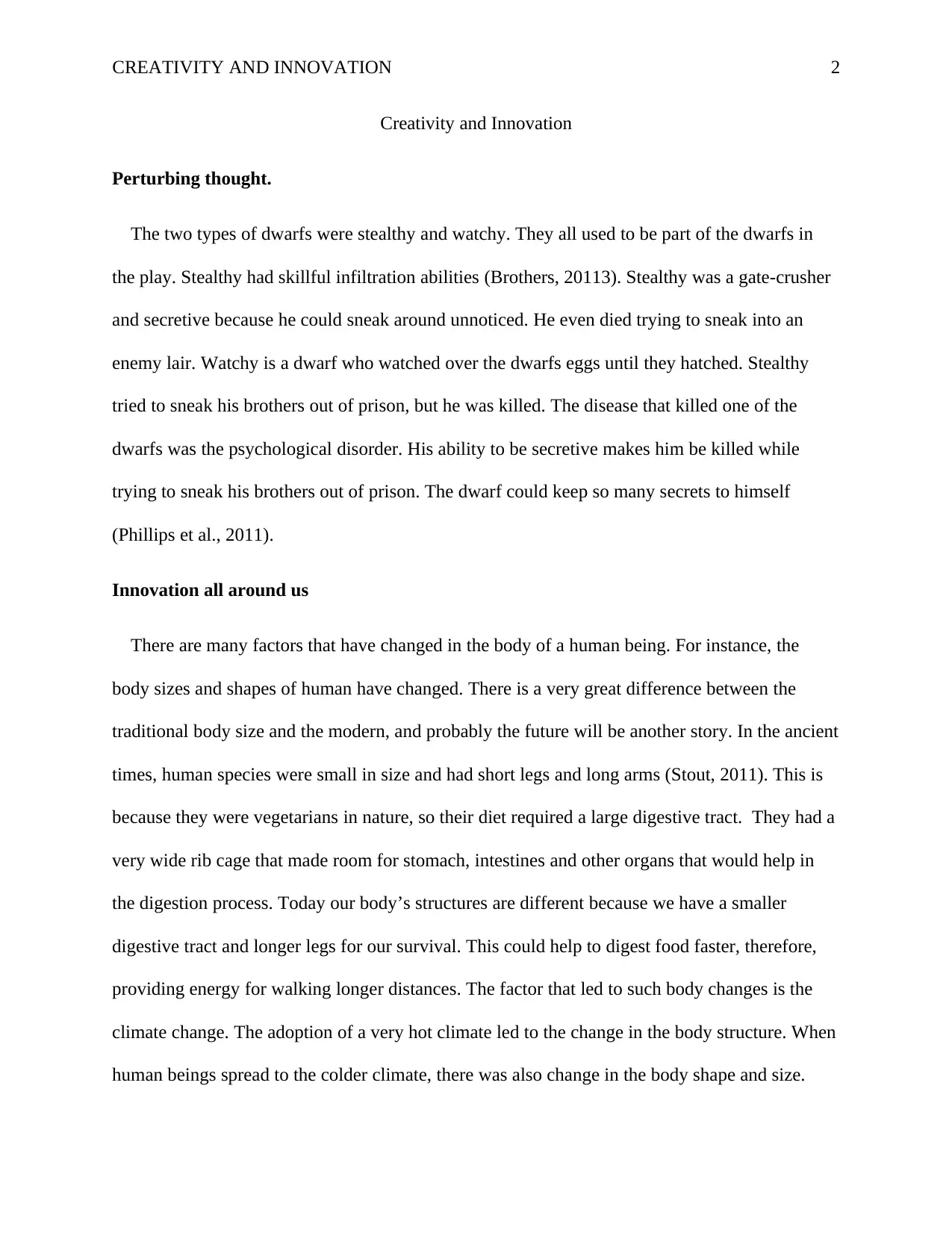
CREATIVITY AND INNOVATION 2
Creativity and Innovation
Perturbing thought.
The two types of dwarfs were stealthy and watchy. They all used to be part of the dwarfs in
the play. Stealthy had skillful infiltration abilities (Brothers, 20113). Stealthy was a gate-crusher
and secretive because he could sneak around unnoticed. He even died trying to sneak into an
enemy lair. Watchy is a dwarf who watched over the dwarfs eggs until they hatched. Stealthy
tried to sneak his brothers out of prison, but he was killed. The disease that killed one of the
dwarfs was the psychological disorder. His ability to be secretive makes him be killed while
trying to sneak his brothers out of prison. The dwarf could keep so many secrets to himself
(Phillips et al., 2011).
Innovation all around us
There are many factors that have changed in the body of a human being. For instance, the
body sizes and shapes of human have changed. There is a very great difference between the
traditional body size and the modern, and probably the future will be another story. In the ancient
times, human species were small in size and had short legs and long arms (Stout, 2011). This is
because they were vegetarians in nature, so their diet required a large digestive tract. They had a
very wide rib cage that made room for stomach, intestines and other organs that would help in
the digestion process. Today our body’s structures are different because we have a smaller
digestive tract and longer legs for our survival. This could help to digest food faster, therefore,
providing energy for walking longer distances. The factor that led to such body changes is the
climate change. The adoption of a very hot climate led to the change in the body structure. When
human beings spread to the colder climate, there was also change in the body shape and size.
Creativity and Innovation
Perturbing thought.
The two types of dwarfs were stealthy and watchy. They all used to be part of the dwarfs in
the play. Stealthy had skillful infiltration abilities (Brothers, 20113). Stealthy was a gate-crusher
and secretive because he could sneak around unnoticed. He even died trying to sneak into an
enemy lair. Watchy is a dwarf who watched over the dwarfs eggs until they hatched. Stealthy
tried to sneak his brothers out of prison, but he was killed. The disease that killed one of the
dwarfs was the psychological disorder. His ability to be secretive makes him be killed while
trying to sneak his brothers out of prison. The dwarf could keep so many secrets to himself
(Phillips et al., 2011).
Innovation all around us
There are many factors that have changed in the body of a human being. For instance, the
body sizes and shapes of human have changed. There is a very great difference between the
traditional body size and the modern, and probably the future will be another story. In the ancient
times, human species were small in size and had short legs and long arms (Stout, 2011). This is
because they were vegetarians in nature, so their diet required a large digestive tract. They had a
very wide rib cage that made room for stomach, intestines and other organs that would help in
the digestion process. Today our body’s structures are different because we have a smaller
digestive tract and longer legs for our survival. This could help to digest food faster, therefore,
providing energy for walking longer distances. The factor that led to such body changes is the
climate change. The adoption of a very hot climate led to the change in the body structure. When
human beings spread to the colder climate, there was also change in the body shape and size.
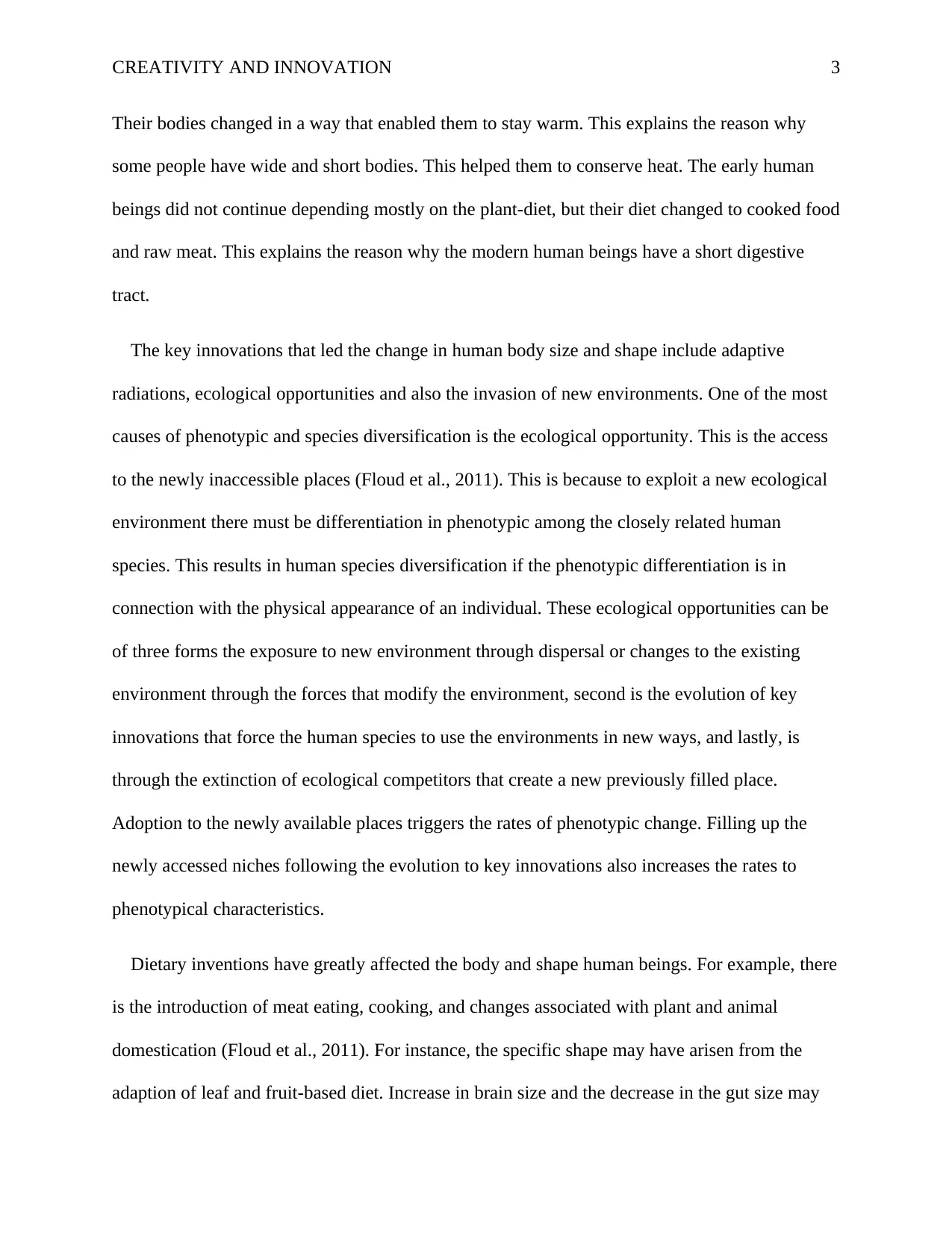
CREATIVITY AND INNOVATION 3
Their bodies changed in a way that enabled them to stay warm. This explains the reason why
some people have wide and short bodies. This helped them to conserve heat. The early human
beings did not continue depending mostly on the plant-diet, but their diet changed to cooked food
and raw meat. This explains the reason why the modern human beings have a short digestive
tract.
The key innovations that led the change in human body size and shape include adaptive
radiations, ecological opportunities and also the invasion of new environments. One of the most
causes of phenotypic and species diversification is the ecological opportunity. This is the access
to the newly inaccessible places (Floud et al., 2011). This is because to exploit a new ecological
environment there must be differentiation in phenotypic among the closely related human
species. This results in human species diversification if the phenotypic differentiation is in
connection with the physical appearance of an individual. These ecological opportunities can be
of three forms the exposure to new environment through dispersal or changes to the existing
environment through the forces that modify the environment, second is the evolution of key
innovations that force the human species to use the environments in new ways, and lastly, is
through the extinction of ecological competitors that create a new previously filled place.
Adoption to the newly available places triggers the rates of phenotypic change. Filling up the
newly accessed niches following the evolution to key innovations also increases the rates to
phenotypical characteristics.
Dietary inventions have greatly affected the body and shape human beings. For example, there
is the introduction of meat eating, cooking, and changes associated with plant and animal
domestication (Floud et al., 2011). For instance, the specific shape may have arisen from the
adaption of leaf and fruit-based diet. Increase in brain size and the decrease in the gut size may
Their bodies changed in a way that enabled them to stay warm. This explains the reason why
some people have wide and short bodies. This helped them to conserve heat. The early human
beings did not continue depending mostly on the plant-diet, but their diet changed to cooked food
and raw meat. This explains the reason why the modern human beings have a short digestive
tract.
The key innovations that led the change in human body size and shape include adaptive
radiations, ecological opportunities and also the invasion of new environments. One of the most
causes of phenotypic and species diversification is the ecological opportunity. This is the access
to the newly inaccessible places (Floud et al., 2011). This is because to exploit a new ecological
environment there must be differentiation in phenotypic among the closely related human
species. This results in human species diversification if the phenotypic differentiation is in
connection with the physical appearance of an individual. These ecological opportunities can be
of three forms the exposure to new environment through dispersal or changes to the existing
environment through the forces that modify the environment, second is the evolution of key
innovations that force the human species to use the environments in new ways, and lastly, is
through the extinction of ecological competitors that create a new previously filled place.
Adoption to the newly available places triggers the rates of phenotypic change. Filling up the
newly accessed niches following the evolution to key innovations also increases the rates to
phenotypical characteristics.
Dietary inventions have greatly affected the body and shape human beings. For example, there
is the introduction of meat eating, cooking, and changes associated with plant and animal
domestication (Floud et al., 2011). For instance, the specific shape may have arisen from the
adaption of leaf and fruit-based diet. Increase in brain size and the decrease in the gut size may
⊘ This is a preview!⊘
Do you want full access?
Subscribe today to unlock all pages.

Trusted by 1+ million students worldwide
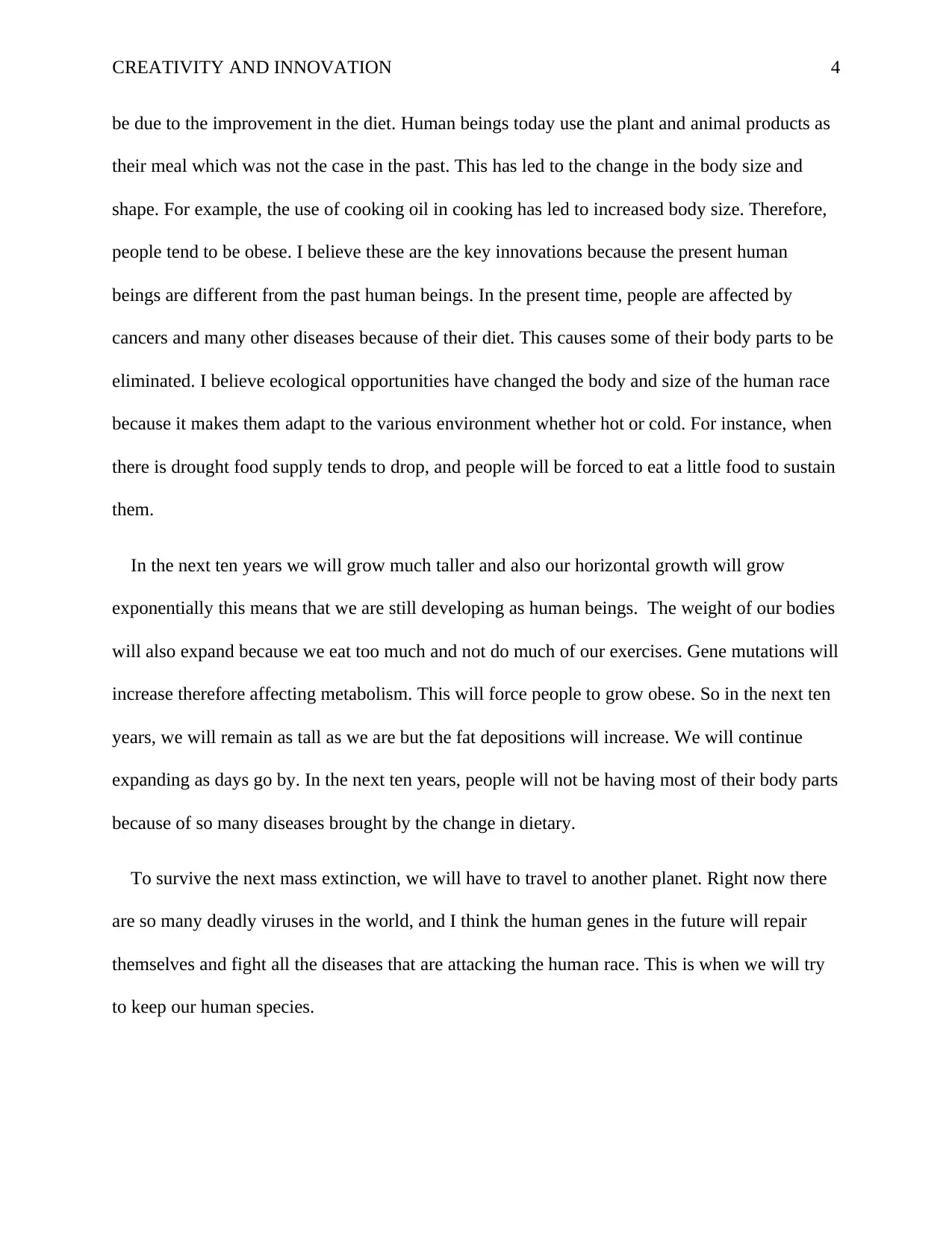
CREATIVITY AND INNOVATION 4
be due to the improvement in the diet. Human beings today use the plant and animal products as
their meal which was not the case in the past. This has led to the change in the body size and
shape. For example, the use of cooking oil in cooking has led to increased body size. Therefore,
people tend to be obese. I believe these are the key innovations because the present human
beings are different from the past human beings. In the present time, people are affected by
cancers and many other diseases because of their diet. This causes some of their body parts to be
eliminated. I believe ecological opportunities have changed the body and size of the human race
because it makes them adapt to the various environment whether hot or cold. For instance, when
there is drought food supply tends to drop, and people will be forced to eat a little food to sustain
them.
In the next ten years we will grow much taller and also our horizontal growth will grow
exponentially this means that we are still developing as human beings. The weight of our bodies
will also expand because we eat too much and not do much of our exercises. Gene mutations will
increase therefore affecting metabolism. This will force people to grow obese. So in the next ten
years, we will remain as tall as we are but the fat depositions will increase. We will continue
expanding as days go by. In the next ten years, people will not be having most of their body parts
because of so many diseases brought by the change in dietary.
To survive the next mass extinction, we will have to travel to another planet. Right now there
are so many deadly viruses in the world, and I think the human genes in the future will repair
themselves and fight all the diseases that are attacking the human race. This is when we will try
to keep our human species.
be due to the improvement in the diet. Human beings today use the plant and animal products as
their meal which was not the case in the past. This has led to the change in the body size and
shape. For example, the use of cooking oil in cooking has led to increased body size. Therefore,
people tend to be obese. I believe these are the key innovations because the present human
beings are different from the past human beings. In the present time, people are affected by
cancers and many other diseases because of their diet. This causes some of their body parts to be
eliminated. I believe ecological opportunities have changed the body and size of the human race
because it makes them adapt to the various environment whether hot or cold. For instance, when
there is drought food supply tends to drop, and people will be forced to eat a little food to sustain
them.
In the next ten years we will grow much taller and also our horizontal growth will grow
exponentially this means that we are still developing as human beings. The weight of our bodies
will also expand because we eat too much and not do much of our exercises. Gene mutations will
increase therefore affecting metabolism. This will force people to grow obese. So in the next ten
years, we will remain as tall as we are but the fat depositions will increase. We will continue
expanding as days go by. In the next ten years, people will not be having most of their body parts
because of so many diseases brought by the change in dietary.
To survive the next mass extinction, we will have to travel to another planet. Right now there
are so many deadly viruses in the world, and I think the human genes in the future will repair
themselves and fight all the diseases that are attacking the human race. This is when we will try
to keep our human species.
Paraphrase This Document
Need a fresh take? Get an instant paraphrase of this document with our AI Paraphraser
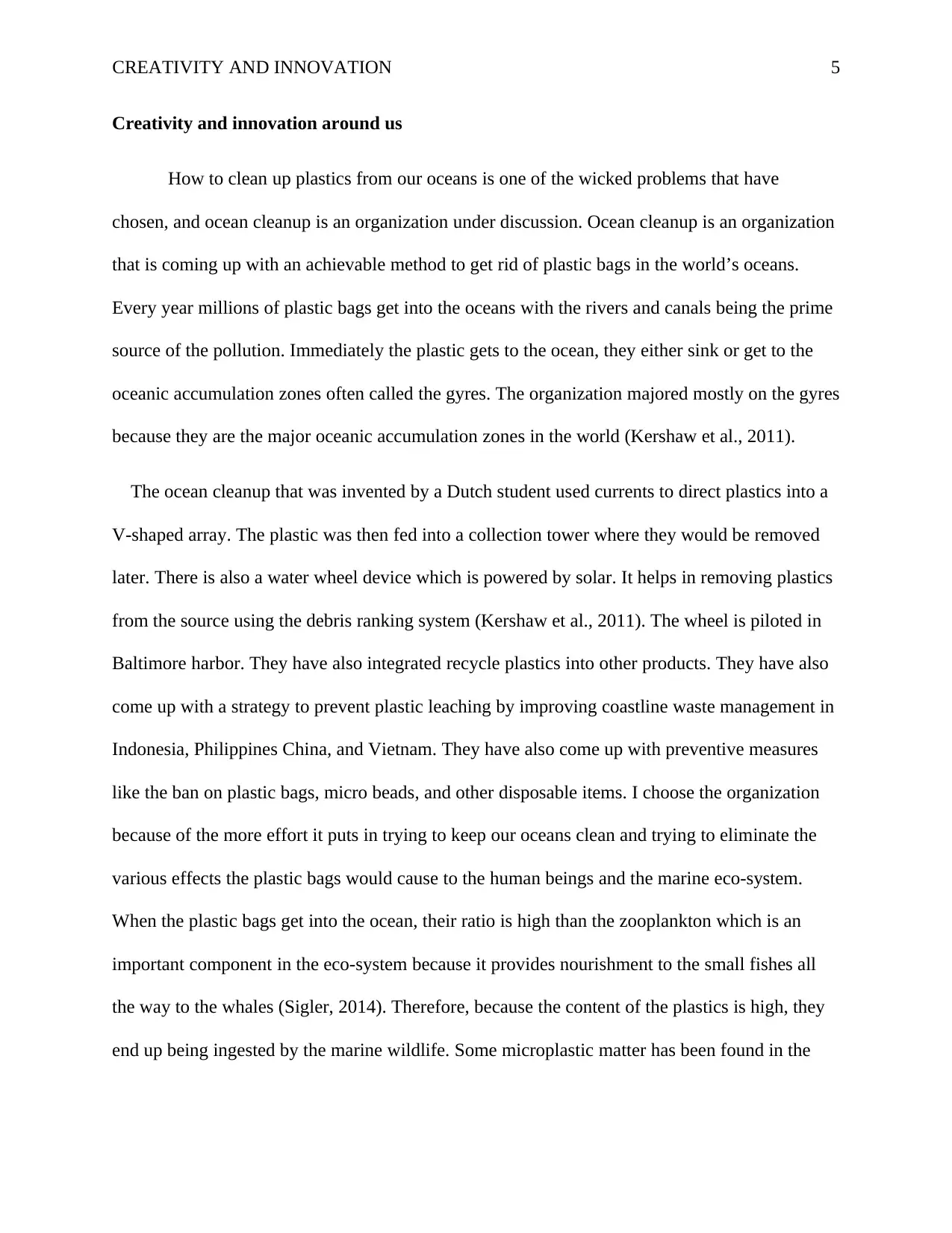
CREATIVITY AND INNOVATION 5
Creativity and innovation around us
How to clean up plastics from our oceans is one of the wicked problems that have
chosen, and ocean cleanup is an organization under discussion. Ocean cleanup is an organization
that is coming up with an achievable method to get rid of plastic bags in the world’s oceans.
Every year millions of plastic bags get into the oceans with the rivers and canals being the prime
source of the pollution. Immediately the plastic gets to the ocean, they either sink or get to the
oceanic accumulation zones often called the gyres. The organization majored mostly on the gyres
because they are the major oceanic accumulation zones in the world (Kershaw et al., 2011).
The ocean cleanup that was invented by a Dutch student used currents to direct plastics into a
V-shaped array. The plastic was then fed into a collection tower where they would be removed
later. There is also a water wheel device which is powered by solar. It helps in removing plastics
from the source using the debris ranking system (Kershaw et al., 2011). The wheel is piloted in
Baltimore harbor. They have also integrated recycle plastics into other products. They have also
come up with a strategy to prevent plastic leaching by improving coastline waste management in
Indonesia, Philippines China, and Vietnam. They have also come up with preventive measures
like the ban on plastic bags, micro beads, and other disposable items. I choose the organization
because of the more effort it puts in trying to keep our oceans clean and trying to eliminate the
various effects the plastic bags would cause to the human beings and the marine eco-system.
When the plastic bags get into the ocean, their ratio is high than the zooplankton which is an
important component in the eco-system because it provides nourishment to the small fishes all
the way to the whales (Sigler, 2014). Therefore, because the content of the plastics is high, they
end up being ingested by the marine wildlife. Some microplastic matter has been found in the
Creativity and innovation around us
How to clean up plastics from our oceans is one of the wicked problems that have
chosen, and ocean cleanup is an organization under discussion. Ocean cleanup is an organization
that is coming up with an achievable method to get rid of plastic bags in the world’s oceans.
Every year millions of plastic bags get into the oceans with the rivers and canals being the prime
source of the pollution. Immediately the plastic gets to the ocean, they either sink or get to the
oceanic accumulation zones often called the gyres. The organization majored mostly on the gyres
because they are the major oceanic accumulation zones in the world (Kershaw et al., 2011).
The ocean cleanup that was invented by a Dutch student used currents to direct plastics into a
V-shaped array. The plastic was then fed into a collection tower where they would be removed
later. There is also a water wheel device which is powered by solar. It helps in removing plastics
from the source using the debris ranking system (Kershaw et al., 2011). The wheel is piloted in
Baltimore harbor. They have also integrated recycle plastics into other products. They have also
come up with a strategy to prevent plastic leaching by improving coastline waste management in
Indonesia, Philippines China, and Vietnam. They have also come up with preventive measures
like the ban on plastic bags, micro beads, and other disposable items. I choose the organization
because of the more effort it puts in trying to keep our oceans clean and trying to eliminate the
various effects the plastic bags would cause to the human beings and the marine eco-system.
When the plastic bags get into the ocean, their ratio is high than the zooplankton which is an
important component in the eco-system because it provides nourishment to the small fishes all
the way to the whales (Sigler, 2014). Therefore, because the content of the plastics is high, they
end up being ingested by the marine wildlife. Some microplastic matter has been found in the
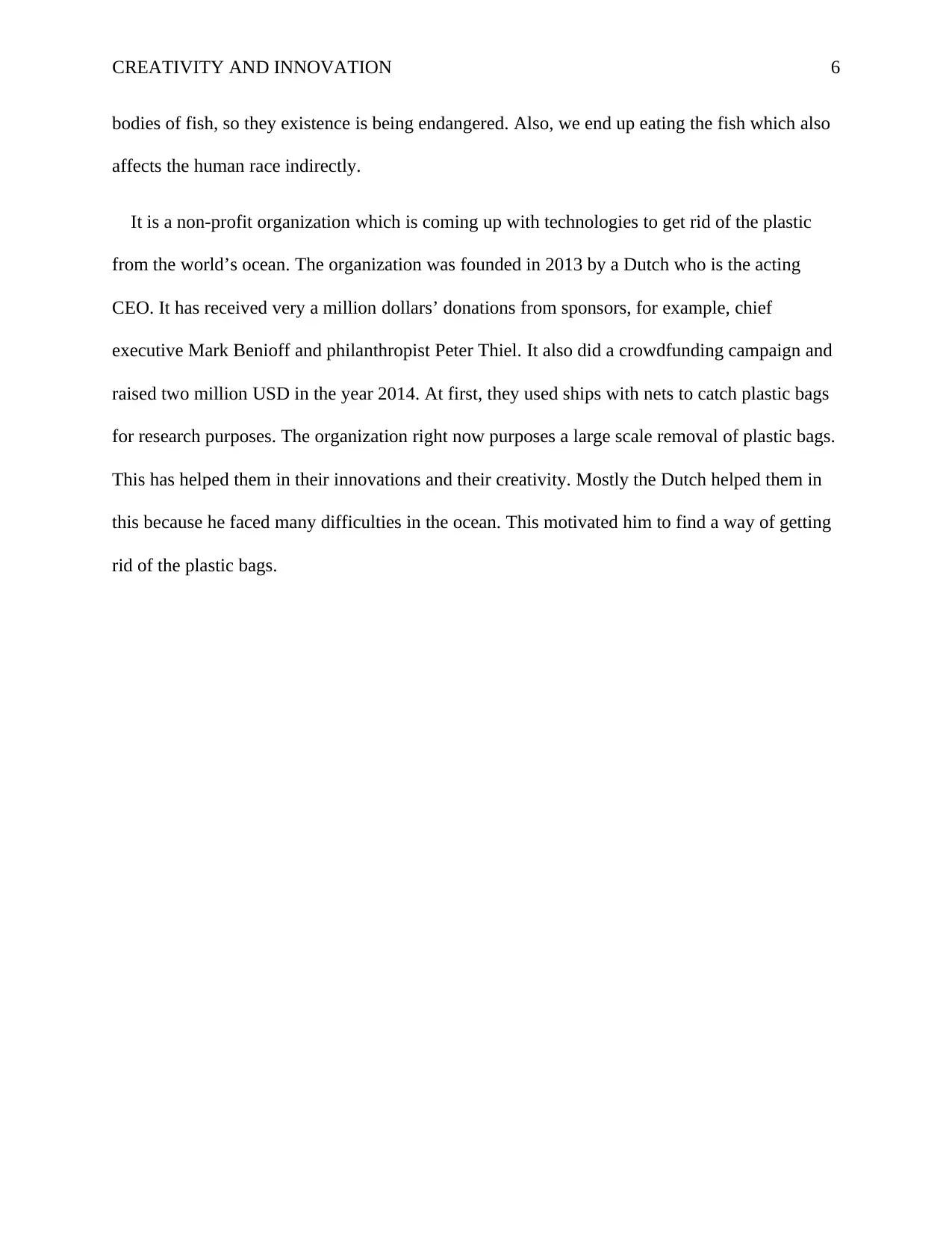
CREATIVITY AND INNOVATION 6
bodies of fish, so they existence is being endangered. Also, we end up eating the fish which also
affects the human race indirectly.
It is a non-profit organization which is coming up with technologies to get rid of the plastic
from the world’s ocean. The organization was founded in 2013 by a Dutch who is the acting
CEO. It has received very a million dollars’ donations from sponsors, for example, chief
executive Mark Benioff and philanthropist Peter Thiel. It also did a crowdfunding campaign and
raised two million USD in the year 2014. At first, they used ships with nets to catch plastic bags
for research purposes. The organization right now purposes a large scale removal of plastic bags.
This has helped them in their innovations and their creativity. Mostly the Dutch helped them in
this because he faced many difficulties in the ocean. This motivated him to find a way of getting
rid of the plastic bags.
bodies of fish, so they existence is being endangered. Also, we end up eating the fish which also
affects the human race indirectly.
It is a non-profit organization which is coming up with technologies to get rid of the plastic
from the world’s ocean. The organization was founded in 2013 by a Dutch who is the acting
CEO. It has received very a million dollars’ donations from sponsors, for example, chief
executive Mark Benioff and philanthropist Peter Thiel. It also did a crowdfunding campaign and
raised two million USD in the year 2014. At first, they used ships with nets to catch plastic bags
for research purposes. The organization right now purposes a large scale removal of plastic bags.
This has helped them in their innovations and their creativity. Mostly the Dutch helped them in
this because he faced many difficulties in the ocean. This motivated him to find a way of getting
rid of the plastic bags.
⊘ This is a preview!⊘
Do you want full access?
Subscribe today to unlock all pages.

Trusted by 1+ million students worldwide
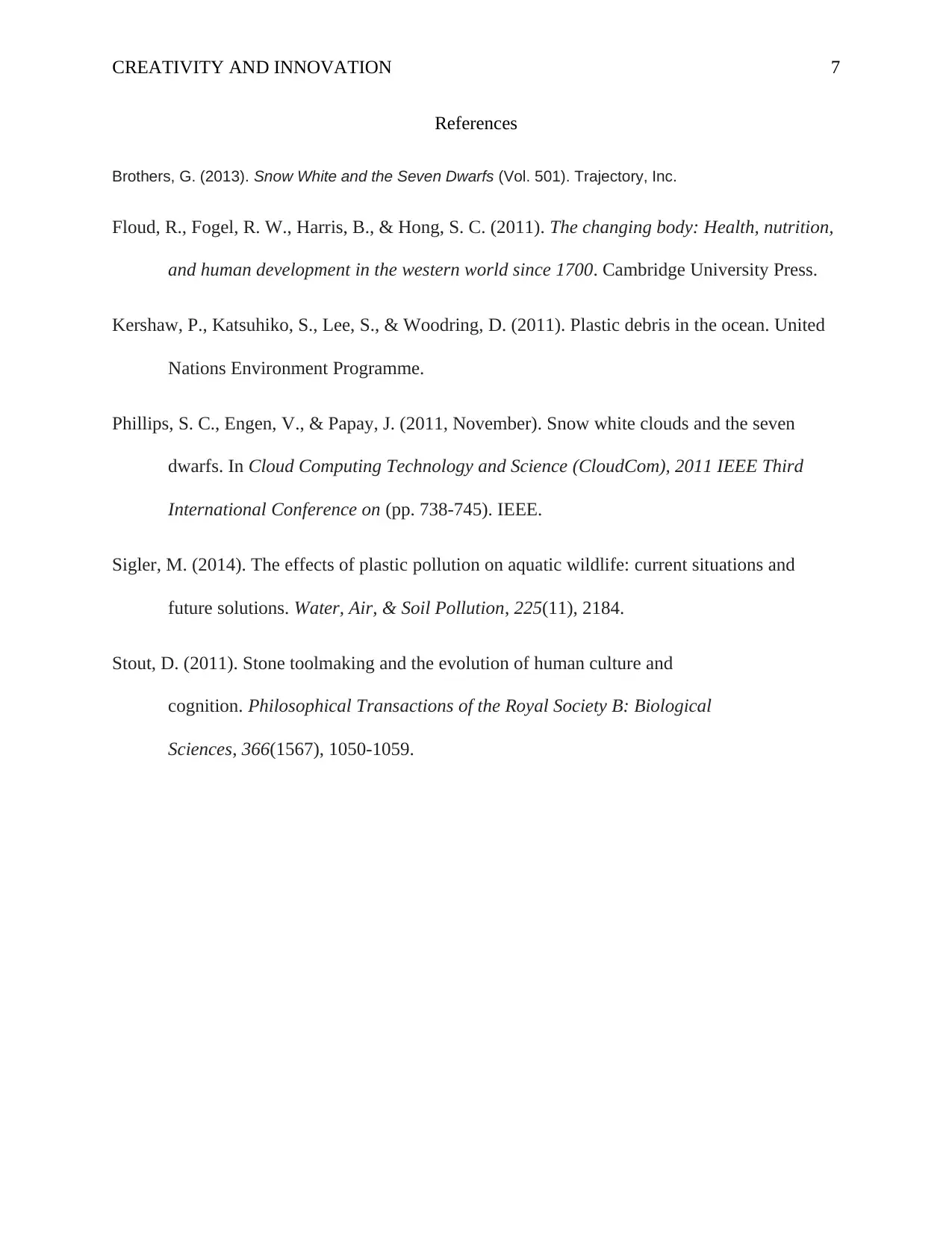
CREATIVITY AND INNOVATION 7
References
Brothers, G. (2013). Snow White and the Seven Dwarfs (Vol. 501). Trajectory, Inc.
Floud, R., Fogel, R. W., Harris, B., & Hong, S. C. (2011). The changing body: Health, nutrition,
and human development in the western world since 1700. Cambridge University Press.
Kershaw, P., Katsuhiko, S., Lee, S., & Woodring, D. (2011). Plastic debris in the ocean. United
Nations Environment Programme.
Phillips, S. C., Engen, V., & Papay, J. (2011, November). Snow white clouds and the seven
dwarfs. In Cloud Computing Technology and Science (CloudCom), 2011 IEEE Third
International Conference on (pp. 738-745). IEEE.
Sigler, M. (2014). The effects of plastic pollution on aquatic wildlife: current situations and
future solutions. Water, Air, & Soil Pollution, 225(11), 2184.
Stout, D. (2011). Stone toolmaking and the evolution of human culture and
cognition. Philosophical Transactions of the Royal Society B: Biological
Sciences, 366(1567), 1050-1059.
References
Brothers, G. (2013). Snow White and the Seven Dwarfs (Vol. 501). Trajectory, Inc.
Floud, R., Fogel, R. W., Harris, B., & Hong, S. C. (2011). The changing body: Health, nutrition,
and human development in the western world since 1700. Cambridge University Press.
Kershaw, P., Katsuhiko, S., Lee, S., & Woodring, D. (2011). Plastic debris in the ocean. United
Nations Environment Programme.
Phillips, S. C., Engen, V., & Papay, J. (2011, November). Snow white clouds and the seven
dwarfs. In Cloud Computing Technology and Science (CloudCom), 2011 IEEE Third
International Conference on (pp. 738-745). IEEE.
Sigler, M. (2014). The effects of plastic pollution on aquatic wildlife: current situations and
future solutions. Water, Air, & Soil Pollution, 225(11), 2184.
Stout, D. (2011). Stone toolmaking and the evolution of human culture and
cognition. Philosophical Transactions of the Royal Society B: Biological
Sciences, 366(1567), 1050-1059.
1 out of 7
Your All-in-One AI-Powered Toolkit for Academic Success.
+13062052269
info@desklib.com
Available 24*7 on WhatsApp / Email
![[object Object]](/_next/static/media/star-bottom.7253800d.svg)
Unlock your academic potential
Copyright © 2020–2025 A2Z Services. All Rights Reserved. Developed and managed by ZUCOL.